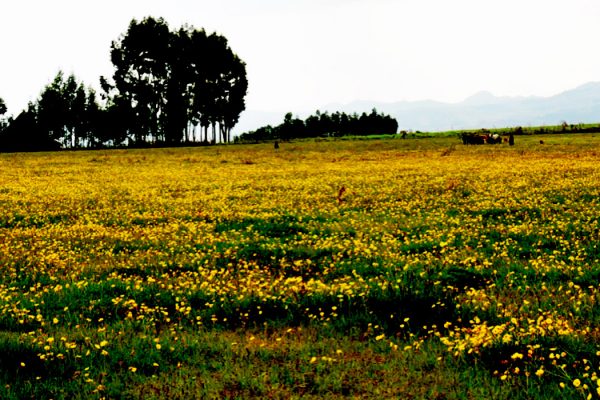
Today Ethiopians in all corners celebrate a New Year, 2014. The New Year comes not only as a mere change in the calendar, but also a transition from a tough cold summer to a pleasant warm spring season. This adds a good reason for many Ethiopians to celebrate it colorfully.
The Ethiopian New Year, or Enkutatash in the Amharic language, unlike the rest of the world, falls on September 11 (or September 12 during a leap year) rather than January 1. Ethiopia has its calendar with 13 months, and each of the 12 months has 30 days, while the 13th month called Pagumen having five days (six in a leap year). The unique calendar of the country considers September and called Ethiopian New Year is as a public holiday.
The holiday is named “Enkutatash”, showing “a gift of jewels” following it is thought that the Queen of Sheba had got back to Ethiopia on this day approximately 3,000 years prior with a gift of jewels from King Solomon of Israel. Besides, the day of the New Year marks a transition from old into the new spirit, plan, and so on.
To celebrate the New Year, a family gathers together and enjoys a traditional meal and drinks. Families, relatives, and neighbours also celebrate together by giving gifts to children. Furthermore, the New Year brings an extended family together to attend a series of events, including the slaughtering of cattle, either a sheep, goat, or cow, depending on a household’s financial capacities.
According to Ethiopian Orthodox Tewahedo Church ancient manuscript researcher Megabe Hadis Rodas Tadesse (PhD), the Ethiopian calendar is very ancient, the oldest, most admired in the world for its unique spiritual and natural elements.
Traditional songs and dances are also common customs of celebration, especially among young girls. Greeting cards have gradually replaced more traditional gifts such as bouquets of freshly picked Adey Abeba that symbolize the arrival of spring as well as paintings of saints. It is also a common to listen to holiday songs that resonate everywhere welcoming the New Year.
Unlike other, holiday celebrations and festivals, the Ethiopian New Year is highly indicated and associates with nature and natural elements. The change of the year is accompanied by natural attraction. Besides, it marks the rainy season is going to an end and the landscape is covered with the mass blooming of the bright yellow flower called “Adey Abeba”, all the bees and birds are starting to fly, the sun will out of the cloud and the Sun shines.
Surprisingly, the bright yellow flower called Meskel daisies or “Adey Abeba” appear only during the New Year time. According to Megabe Hadis Rodas, Adey Abeba flower has remained lifeless throughout the year, and it manages to reclaim life when the New Year comes. It blooms only for the New Year. So, Adey Abeba considers as a flower symbolizing the renewal of life, which communicates to people, in its way, that there is still hope for a better life.
The Adey Abeba flowers indeed indicate that no matter how miserable and unfortunate our past has been, anyone still can rejuvenate his or her life like Adey Abeba. Additionally, it symbolizes the coming of the new season of sunshine after the end of the rainy season.
The lighting of wooden torches it is also known as “chibo” in the local language, is a season indicator of the Ethiopian new year. On the night of the eve of the Ethiopian New Year, each household, neighbours, or villagers light wooden torches in the group which symbolizes the coming of the new season of sunshine now that the rain season comes to its end. As it comes with the change of the season, the New Year in Ethiopia is celebrated with new hope, and the people are making special preparations.
Ye meskel wof or Meskel Bird is a sessional bird that appears once a year in the month of September or a new year in Ethiopia when the flower is blossoms following the end of the chilly, cloudy and rainy season in Ethiopia. Ye Meskel Wof, indigenous Ethiopian birds fly over the skylines of cities and villages across the country only once in September.
According to Solomon Dibaba, ‘ye Meskel Wof’ is used to call the four bird species, namely the northern red bishops, indigo-birds, whydah, and widow birds, and yet it has more than ten species under it. These birds are endemic to Ethiopia and do not migrate from one place to another as other birds do. As of September, Ethiopia’s first month, is their reproduction season, the colors of their feathers get changed to attract opposite sexes. Due to this change, it looks that they are new birds that appear only at this time of the year.
Megabe Hadis Rodas said the source of the Ethiopian calendar is emanating not only from foreigners, but it is also taken the nation indigenous plant Adey Abeba, Birds, and cultural activities of the country. The yellow flower indicates that the fog, the cold, the frost, the thunderstorm, and the terrible season are over. It also signifies the sun rises in September and overcomes the clouds.
Enkutatash marks the end of the three-month rainy season when bright autumn days return to the vastly highland nation. It is also complemented by seasonal indicators such as yellow flower Adey Abeba, Ye meskel wof or Meskel Bird, and “chibo”. These are highly connected with our planet earth. Because the New Year comes at the time when the heavy rainfall starts to cease and the bright sun comes to shine over the green land, which is also covered by the flower. Conservation, therefore, of the environment and the earth will assistance to repeatedly see Adey Abeba, Yemeskel wof or Meskel Bird, and “chibo” every year.
BY EPHREM ANDRGACHEW
The Ethiopian Herald 11 September 2021




